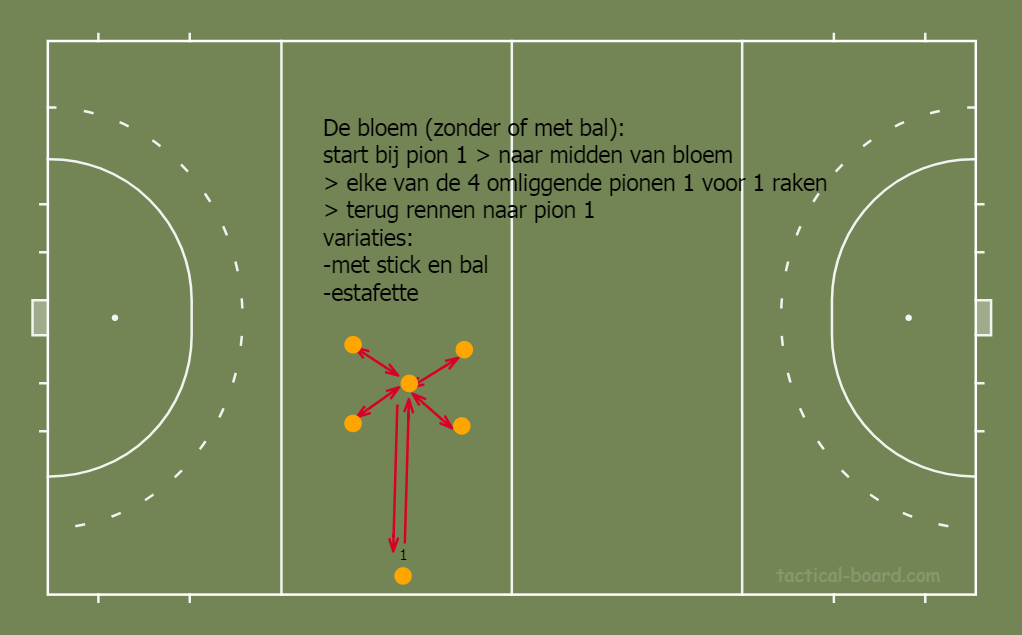Hockey drills for technique warming-up
- Groups of 2 in a row.
- There is one tagger and one runner.
- The one who has to run away, because otherwise he will be tapped, will quickly stand in front of 2.
- The last one of these two has to run away quickly in order not to be tapped, because 3 is too much! If you get tapped, you become the tagger.

- 1 or 2 taggers.
- On the spot where you are tapped, the tagger must hold his hand, for example, a hand on his shoulder.
- With the other hand another has to be tapped.

- One tagger has a stick in one hand and taps with his other hand.
- The tagged player will then hold the stick with it and also tap with it.
- The tagger must not let go of the stick.
- If there is a large group, assign two or more taggers.

- 1 player has a stick and a tagger is assigned;
- only the player who has the stick may be tapped, so the stick is always passed on quickly (vertically for safety reasons and do not throw it!).
- If the tagger doesn't have a chance, add more than one stick to the game.

- There are 3 or 4 gates in the indicated area.
- To score a point you have to pass the ball to a team-mate through a gate.
- After scoring, the other player can score if they are in possession of the ball.

- Everybody's got an inverted pylon he puts in the area.
- Everyone protects his own pylon and tries to shoot another pylon (the owner gets a penalty point; who has the most/least penalty point after 5 minutes?).

- Run towards goal, play the ball to the left towards the trainer, the trainer plays the ball back into the runner's stick.
- After receiving the ball, he finishes on target.

- 2 groups of 5 hoops.
- All 5 children are standing at a hoop
- One of the kids has the ball and starts pushing to each other.
- Which group is the first to play the ball 3 times around (counterclockwise).
- Of course you can also have 2 groups of 4

- The group is divided into 2 groups ( try boys who have to play together in the game across the board (far-mid or all defenders; all midfielders,...))
Playing field : 1/4 of the field over the entire width of the field.
- Exercise : The toss determines which team has ball possession.
- This group tries to visit all the houses on the playing field, after each visit the group has to get a key from the goalkeeper who is standing in a box in the middle of the field.
- You get the key by playing the goalkeeper and he has to kick the ball back to a member of the group.
- The house has to be approached by at least 3 people.
- Then a group member may stand in the house and receive the ball and play it back.
- The team may NOT have someone in the house in advance.
- Everything goes on time.
- After group 1, group 2 starts.
- Group 2 has to improve the time of group 1...
- The second version is with defense by the other group.
- Who scores the most houses in 10 minutes.
- Scoop is allowed in free space... houses may not be defended by a team... A house = a square with 4 pilons...
The flower (without or with ball):
- start at pilon 1 > to the center of the flower
- hitting each of the 4 surrounding pilons 1 by 1
- run back to pilon 1
- variations:
- with stick and ball
- relay race

- The group is positioned in the four corners of the field.
- One who tags has to wear a party ribbon
- On a sign, they cross the field in three directions of their choice:
- the short side, the long side or diagonal.
- This results in one, two or three points each time they return.
- A tagger operates in the free space and obliges the tagged children to first go back to their corner before they may cross again.
- How many points can you score in a set time?
- The group is lined up on the short side of the field for a relay.
- On a sign they all run to the other side at the same time and try to sit down as soon as possible in a random order.
- Which line-up will be the first to sit down?
- Variation
- Varying start and end positions.
- Touching a line on the opposite side, returning and sitting in line again.







